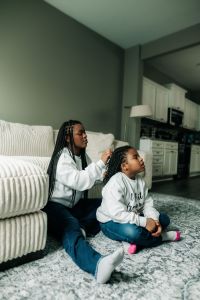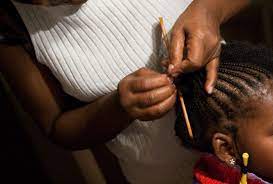A fresh lineup and a fade that never goes out of style to retwist on locs, a silk-press during the winter months, braids right before vacation or embracing the natural afro and curls all year long are just a few different hairstyles that transcend in the Black community. Everyone wears their crown(hair) differently and that’s what makes us individuals unique. Hair is a simple way to express oneself. You can be creative and show your sense of style with your hair.
In my second year of teaching (2021-2022) I had a young female student who had sweated out her hair in gym class. The student came to me in a panic because her hair was frizzy and puffing up. At first she tried fixing it herself using my mirror in the back of the classroom, but I could tell she was getting frustrated. At first I didn’t intervene and allowed her to try to fix it herself. During that time I constantly reassured her that her hair didn’t look bad and it can be fixed. I did offer my assistance but I knew some students may only trust certain people to do her hair so I didn’t push. When she finally asked for help I immediately sat her in my chair and went into my desk drawer where I keep extra hair products and supplies and got started on fixing her hair. All I did was a slick back bun with baby hairs but that simple hairstyle was enough to get that student through the day.
Did me doing her hair at the start of class period hurt anyone… ? No. Did any of my other students take offense …? No. The only thing that occurred from me doing this student’s hair is a boost in confidence, truly creating an inclusive classroom… and I got to show off some skills. But the main thing it did was show my students I’m here for them in every aspect of life.
“The main thing it did was show my students I’m here for them in every aspect of life.”

In the Black Community, “hair” is very important. Many young men and women look forward to sitting in the barber and beauty shop. It is a place where the old and younger generations can vent, cry, celebrate and story-tell. Also it can be a set time that is carved out every week where parents and guardians have quality and individualized time with their child. Hair becomes a focal point for where bonding can happen and can take hours to get done. When a student is having a bad day sometimes it can be based on the fact their hair isn’t done or is messed up.
How can you help?
Some students will willingly come to you and ask for you to help them fix their hair but some students may be too embarrassed. Some signs you may see are students trying to cover their heads by putting their head down, wearing hats, hoodies or even fixing their hair in class or asking to be excused with hair products in their hands.
When you witness these “signs,” don’t immediately become defensive because the student is participating or behaving in class like you expect instead give that student grace. Offer your assistance to help with their hair or if you don’t know how to do it send them to another teacher who does, allow them to use a mirror in your class or let them go to the restroom real quick to fix their hair. These three examples create a safe space and build trust between you and your students. There have been numerous times while I am getting my class started on bellwork or reviewing that I have students in my chair and I’m fixing their hair. It doesn’t take away from the learning environment; if anything, it strengthens it.
“It doesn’t take away from the learning environment; if anything, it strengthens it.”
What’s Next?
In American culture there have been many stereotypes around Black hair – the “Afro is the rebel,” “braids are long and ghetto,” and “locs aren’t sanitary” – but these things are all untrue. As educators it is our purpose to make sure all children in our classrooms feel embraced and we’re instilling confidence.
If you have ever been told or had any intrusive thoughts about Black Hair this blog will help you learn about hair in the Black culture and how many hairstyles that are worn by Black people connects all of us to the Black Diaspora. The second part of this series we will look into ways that you can be prepared for when a student may not like their hair and how you can be a resource for them.
Please login or register to claim PGPs.
Alternatively, you may use the PGP Request Form if you prefer to not register an account.



